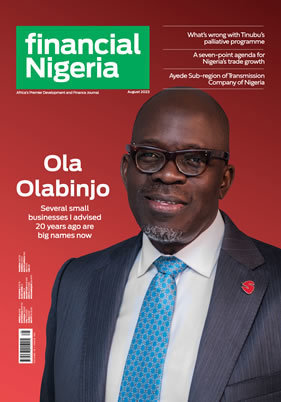
Jide Akintunde, Managing Editor/CEO, Financial Nigeria International Limited
Follow Jide Akintunde
![]() @JSAkintunde
@JSAkintunde
Subjects of Interest
- Financial Market
- Fiscal Policy
Ending poverty requires poverty economy 08 Nov 2022
The United Nations Sustainable Development Goal 1 seeks to “end poverty” globally. But the world is not on track to achieve this lofty goal by the target year 2030. For instance, according to a World Bank counterfactual scenario, if Covid-19 had not hit, the absolute number of poor Nigerians was set to increase from 82.9 million in 2019 to 90.0 million in 2022. With the economic effects of the pandemic, however, the country’s poverty headcount will reach 100.9 million by the end of 2022.
Poverty has health, education, and living standards dimensions, according to Oxford University’s Global Multidimensional Poverty Index. But ending multidimensional poverty requires ending “poverty economy.” Poverty economy has many accustomed features. In Nigeria, they include persistent double-digit inflation and political leaders fighting poverty with their words while compounding the problem by their actions.
Huge amount of cash outside the banking system, and dirty and mutilated notes – essentially due to poor handling by the country’s teeming poor and because of the low purchasing power of the naira – are also trademarks of Nigeria’s poverty economy. These issues will at best be momentarily solved when the CBN introduces new naira notes from next month.
Two sectoral components of Nigeria’s poverty economy are agriculture and oil. Our poverty agriculture economy is signposted by low-productivity, subsistence farming, and exportation of primary produce. According to data by the Food and Agriculture Organization of the United Nations (FAO), Nigeria’s cereal yield per hectare was 1,420kg in 2020. For Ukraine, it was 4,296kg; 5,407kg in South Africa; and 8,175kg in the United States.
This reflects disparities in human capital as much as other variable agricultural inputs. In 2019, the value added per worker in Nigeria’s agriculture, forestry, and fishing was $5,591.2, while it was $100,061.65 for the US sector worker, according to World Bank data. With 70 percent of Nigeria’s labour supply employed in largely subsistence agriculture, low productivity predominates in the economy. And by not adding value to produce before exporting them, earnings and job creation are depressed.
Lack of value addition before export sees the country exporting crude oil and unable to generate jobs in a sector that for decades accounted for over 70 percent of government revenue. From the early 2000s when the prices of some raw commodities, most notably crude oil, began an uptrend, Nigeria and other commodity exporters in Africa were thought to be rising economically. But two decades later, it was China that clearly has risen to become a global economic superpower by using the commodities it was importing from Africa and elsewhere to fuel its domestic industrial growth and export of finished products. In contrast, Nigeria is now unable to finance the subsidy on imported petroleum products after exporting its oil in crude form (pun suitably intended).
As if the situation is not bad enough, Nigeria’s poverty economy has been facing serious threats. For years now, farming communities have been affected by insecurity. Climate change is now intensifying threats. Last month, swathes of farmland and farming communities were taken over by flood. The financial and human tolls are tragic, and their impact will likely endure.
Climate-induced natural disasters, like flood and drought, are likely to become more regular and severer as progress in limiting global warming to 1.5 degrees Celsius compared to pre-industrial levels has been slow. Whereas Nigeria has struggled with industrialising its agriculture for decades, the urgent need now is to build climate resilience in the sector.
But many still take the climate emergency, at best, as a problem to be solved by some other countries – countries whose industrialisation precipitated global warming, which causes climate change. Thus, last month, Bola Tinubu, the presidential candidate of the ruling party, deployed a “church rat” and “poisoned Holy Communion” metaphors in response to the need for climate action in Nigeria. He suggested that Nigeria is unable to provide climate change mitigation and adaptation measures without external grant financing. With this posturing, vulnerable citizens will continue to lose their lives/livelihoods if adequate external help does not materialise. But dependence on foreign aid itself is only but another facilitator of Nigeria’s poverty economy.
As climate change is putting Nigeria’s agriculture at risk, even so mitigation measures, chiefly cutting down carbon emissions, will significantly impact the oil economy after the next decade. This calls for electing in 2023 a president that can best lead the transition of the economy and the early stage of its transformation.
With regard to agriculture, the first order of business now is to restore security and introduce climate change adaptation mechanisms, closely followed by industrialisation of the sector. Enabling disaster-proof and recovery of farming communities is key. It will require various mechanisms, including state-sponsored crop insurance – such as practiced in India – to guarantee and improve the income of farmers. Government at both federal and subnational levels also needs to take flood control more seriously by pro-actively investing in hard and soft infrastructures and coastal management measures.
The oil economy has made a strong comeback in international news headlines because of geopolitics since the Russia-Ukraine war. But within industries, innovations that will effectively end the ‘oil age’ are progressing. Nigeria’s non-oil economy needs to take the centre stage. We have to refocus on creating an innovation economy to foster inclusive prosperity. The bedrock of this is adequate investments in education, health, and livelihood.



